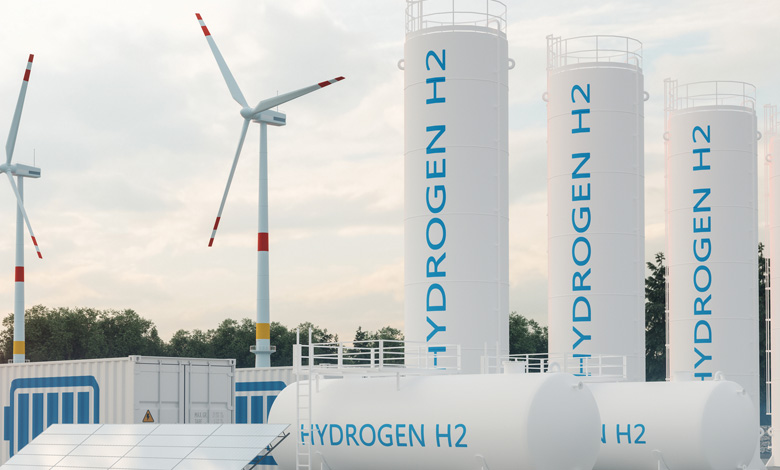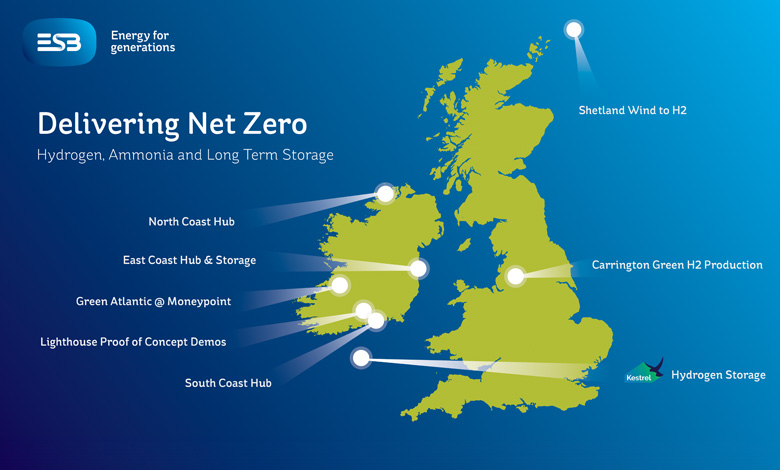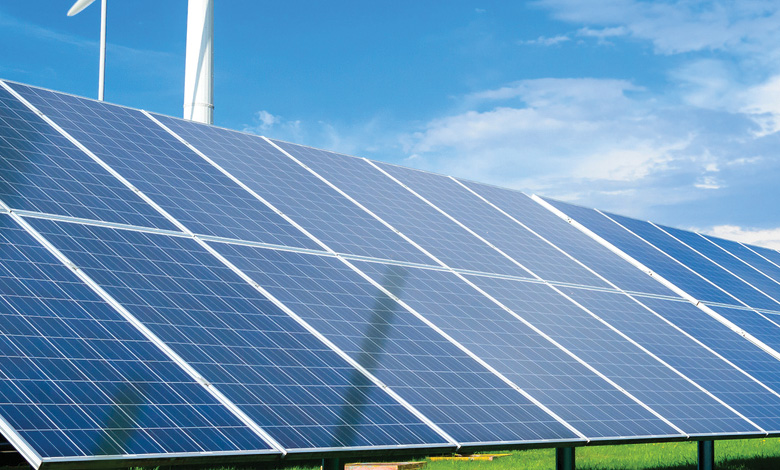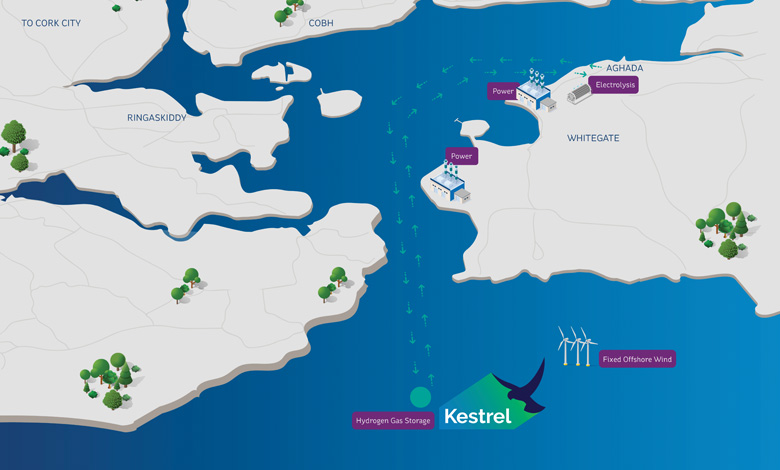The role of renewable hydrogen in a resilient and secure net zero electricity system

Meadhbh Connolly, Future Opportunities Manager at ESB, explains why the decarbonisation of the electricity system requires more than just renewable energy generation and how ESB is committed to supporting the delivery of a net zero future for Ireland by investing almost €2 billion every year.
Renewable hydrogen is becoming a crucial and strategic choice for the energy transition which can help Ireland reach its net zero emissions target while adding security to the energy system. It can be made from renewable electricity and water, stored in large quantities for long periods and then used as a carbon-free fuel for backup power, replacing the fossil fuel energy sources we have depended on for decades.
ESB’s almost €2 billion every year is being invested to aid the delivery of Ireland’s climate target objectives across the energy sector as part of the organisation’s ambitious commitment to achieving net zero by 2040. At a national level, there is a legally binding target to achieve net zero emissions by 2050. As a result, Ireland must transform its energy system from fossil fuel-based to zero carbon in the coming decades.
“The World Energy Council refers to the energy trilemma: sustainability, security, and affordability. Renewable hydrogen can play a central role in security of supply and resilience in a net zero future – ensuring that demand for electricity can always be met and that the power system can cope with and recover from shocks and stresses,” says Connolly, who adds that for decades, the power system has been secured through energy stored in the form of coal, peat, oil, and gas. “A fleet of thermal power plants turned these fossil fuels into electricity when required. We now need to find a low carbon solution for this energy storage and ‘dispatchable generation’ i.e., generation that can turn on or off as needed, which is not always possible with weather-dependent renewables.”

The scale of the required energy storage is beyond what can be achieved using either batteries or pumped storage, although both will be essential players in the net zero power system of the future.
Future options
- Carbon capture and storage (CCS): This technology involves capturing the carbon dioxide (CO2) emitted from fossil fuel power plants and storing it underground. However, CCS has not been commercially successful to date for power generation, as it is costly and complex. Moreover, CCS reduces the efficiency of power plants, thereby increasing the reliance on natural gas for a given power output. For technical and commercial reasons, CCS plants require to run most of the time, and this would result in the system operator ‘dispatching down’, or reducing the output from, renewable energy sources. CCS also does not eliminate CO2 emissions, leaving a residual CO2 legacy for future generations.
- Nuclear power: This technology uses nuclear fission to generate electricity with low CO2 emissions. However, nuclear power is prohibited by the Electricity Regulation Act 1999. It would take decades to develop the policy and regulatory frameworks to build and operate a nuclear plant, making it unlikely to contribute to the 2050 target for Ireland. Moreover, nuclear power is better suited as a base-load plant. In fact, nuclear and renewables are competing primary-energy options with greater nuclear penetration, requiring less renewables to generate the zerocarbon energy needed.
- Biofuels: Biofuels are made from organic matter, such as wood, crops, or waste. They can be used to produce electricity with lower CO2 emissions than fossil fuels, depending on the material and the method of production. However, there are limited domestic resources of biofuels in Ireland and, therefore, need to be used carefully and selectively, depending on the supply, price, and sustainability of biofuels, as well as the demand, efficiency, and emissions of different sectors. The best use of biofuels is in sectors that have fewer options to use electricity, such as industry, shipping, heavy-duty road transport, and aviation.
- Interconnection: Interconnection has an important role to ensure efficient trading of electricity, however, interconnection is only part of the solution to ensure security of supply as sometimes the weather patterns are similar in different regions and there is not enough wind or sun on either side of the interconnector to meet the power needs.
Connolly outlines that ESB has analysed almost two decades of weather data from Ireland, France, Great Britain (GB) and Spain. “The analysis shows that there is a high correlation between wind patterns in Ireland, France, and Great Britain. This means that when there is low wind in one country, there is likely to be low wind in the others as well. This happened in 2021, when there was a period of up to six weeks of low wind in all these countries.”
There is a “negative correlation” between solar power in Spain and wind power in Ireland, she adds. This means that when there is more sun in Spain, there is less wind in Ireland, and vice versa. This suggests that interconnection with Spain could help balance the supply and demand of renewable energy in Ireland. However, there are also some years when both wind and solar power are low or high in both countries. For example, in 2010, there was a ‘low wind’ year in Ireland and a ‘low solar’ year in Spain. This means that interconnection alone cannot solve the problem of surplus or shortage of renewable energy. “Therefore, interconnection has a necessary but insufficient role to play in achieving net zero by 2050,” Connolly explains.
In summary, the above alternative solutions are either not viable or not sufficient for Ireland to achieve a resilient, secure net zero electricity system by 2050.

“Renewable hydrogen, on the other hand, offers a unique opportunity to harness the abundant wind resources in Ireland, while providing flexibility, stability, and storage for the electricity grid.”
“Interconnection has a necessary but insufficient role to play in achieving net zero by 2050.”
Meadhbh Connolly, Future Opportunities Manager at ESB
Renewable hydrogen: What is it and why is it important?
“Renewable hydrogen production opens the option of flexible demand which is valuable in a power system dominated by renewables because the demand can be switched off during periods of low renewables and ramped up when there is surplus. Renewable hydrogen can also create new economic opportunities for Ireland, such as building a domestic hydrogen industry, exporting hydrogen or its products to other markets, and attracting new investments and jobs in the green economy,” states Connolly.
How can renewable hydrogen help achieve secure and resilient net zero electricity?
Resilience is increasingly important for the electricity system in the context of electrification of the transport and heat sectors – where our reliance on electricity is much higher.
“As we transition to net zero, the geopolitical risks associated with the physical supply and price of fossil fuels will be replaced with the meteorological risk associated with weather-based power systems,” says Connolly.
The recently published National Hydrogen Strategy called out the role of renewable hydrogen in a net zero electricity system: by reducing the carbon emissions of the conventional generation that will still be needed to fill in the gaps when variable renewable electricity is low and by storing electricity from variable renewable generation to support the grid and deal with seasonal wind changes. A recent report from the IEA suggests that zero carbon dispatchable generation, which can use renewable hydrogen in gas turbines or fuel cells, will provide between 5 and 15 per cent of electricity needs in a net zero power system to ensure system reliability and efficiency.
“Ireland has the unique capability to produce enough renewable energy onshore and offshore to meet multiples of our energy demands. Renewable hydrogen enables storage of this energy to cover multiple weeks of electricity demand,” she adds.
The enablers
The National Hydrogen Strategy is a positive step towards the development of hydrogen as a key pillar of a secure net zero economy, complementing our vast renewable energy resources. The strategy identifies the need for regional clusters where production, high demand users, and large-scale storage are near each other so that hydrogen infrastructure can be used by more than one party. Long-term underground storage of hydrogen is acknowledged as crucial for the future cost-effectiveness and price stability of hydrogen.

“There are challenges to overcome to make hydrogen a viable and competitive option in the energy market. Ireland can look at best practices and lessons learned from other countries that have advanced their hydrogen agendas and supported their hydrogen industries.” For example, Germany, France, Netherlands, and the UK have all adopted national hydrogen strategies underpinned by concrete targets, measures, and funding mechanisms for scaling up hydrogen production and consumption. Some of the key elements of these strategies are:
- a funding scheme that can bridge the cost gap between fossil fuels and low-carbon alternatives, such as hydrogen;
- incentives for investment in large infrastructural projects such as underground gas storage and hydrogen clusters, leveraging EU schemes that can facilitate access to public funding and state aid, as well as foster cross-border collaboration and innovation; and
- commercial frameworks and supports that incentivise existing and new thermal power plants to transition away from fossil fuels.
- “By replicating and adapting these best practices and frameworks to the Irish context, Ireland can create a conducive and attractive environment for hydrogen development and innovation and achieve its net zero power system goals,” adds Connolly.
ESB generation and trading activities and plans
“ESB believes renewable hydrogen will play a critical role in the decarbonisation of many sectors. We plan to use our existing capabilities and future renewable growth to become a leading player in large scale renewable hydrogen production, thereby enabling renewable electricity to meet the energy requirements of Ireland’s future zero carbon economy.”
In partnership with dCarbonX, Snam, and Bord Gáis Energy, ESB is proposing to redevelop the decommissioned gas reservoirs in the offshore Kinsale gas fields for large-scale storage of hydrogen whilst initially offering the possibility of natural gas storage as a strategic reserve until large volumes of hydrogen are available for storage. The Kestrel Project represents a unique opportunity to deliver large scale energy security of supply which, in turn, will support the expansion of renewable energy production (wind and renewable hydrogen) in the years ahead. ESB and Bord Gáis Energy operate significant electrical generation at the nearby Aghada and Whitegate gas-fired power stations and the integration of essential large-scale storage will support the transition of these stations to net zero emissions in the future.
ESB will also develop renewable hydrogen production, storage and zero carbon dispatchable generation at Moneypoint in County Clare, as a key component of the Green Atlantic @Moneypoint project.
ESB is also developing a lighthouse project on our site in Aghada, County Cork to demonstrate the production of hydrogen for use in zero carbon power generation technology. This proof of concept will help ESB to build its fleet of zero carbon dispatchable generation assets which support intermittent renewables.
As part of the HyNET low carbon cluster in the UK, ESB is working with industrial partners and turbine manufacturers to get Carrington power station ready to use hydrogen as a fuel for producing decarbonised power. The learnings from this project will help us reduce the carbon emissions of ESB thermal plants in Ireland and develop zero carbon energy clusters at strategic coastal sites in Ireland.
The journey to net zero
Ireland has an ambitious Hydrogen Strategy which needs to be underpinned by effective policies, regulations, and funding mechanisms. ESB will leverage its expertise and experience to support delivery of these. A net zero power system requires dispatchable generation capacity and energy storage facilities to ensure a reliable and robust supply of electricity. Renewable electricity and renewable hydrogen can cooperate to securely transition to a net zero power system. “ESB’s strategy to reach net zero by 2040 will help build the four main infrastructure elements: renewables, hydrogen production, hydrogen storage, and zero carbon on-demand power generation at strategic clusters, to provide a secure, resilient, reliable net zero power system,” says Connolly.
For more information, visit:
W: www.esb.ie






